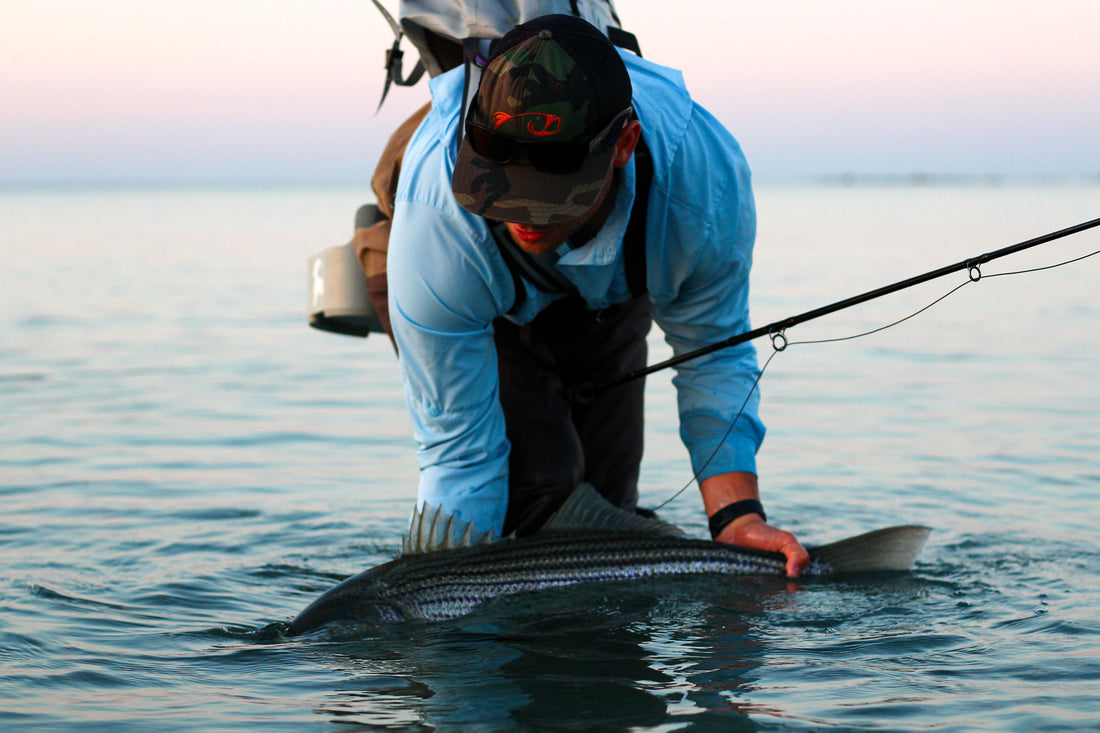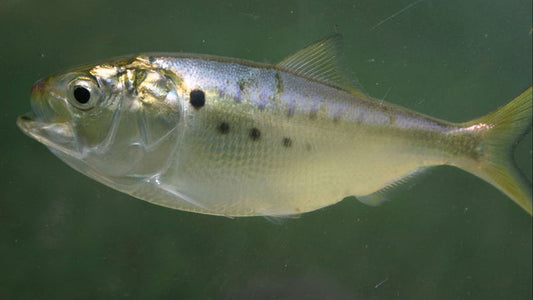
Leader Setups for New England Striped Bass
Share
Written By: Joe Webster / Photo By: Josh Thelin
How you set up your leader and knowing when to use what leader design will make all the difference in how a fly casts and also how fast or slow your fly and leader setup might sink. There are no finite rules about leader set up but there are definitely some helpful guidelines to follow. In this article, we hope to at least help point you in the right direction. We will break it down by type of fly line as they generally require different set ups.
Floating lines:
Leaders used for floating lines will generally be longer in length than those used on intermediate and sinking lines. Floating lines in the striped bass world are most commonly used for sight fishing in skinny water scenarios or for throwing top water flies like poppers or gurglers. Both of these scenarios require very different leader set ups. For sight fishing scenarios and in dealing with spooky fish it is important to keep your fly line as far away from the fish as possible. This means running a long leader, sometimes 12-15ft. Often smaller shrimp and crab flies are used in these situations, very similar to targeting bonefish or permit on flats so a leader that is capable of turning over a large heavy and air resistant fly is not a requirement. With this being said a leader that tapers down to a 12lbs or 16lbs is common place with striped bass flats anglers, if anything just to match up with the smaller sized offerings being presented (tippet should always be matched to the size of a fly and not used for its pound test rating). A very useful and versatile way of achieving this is to start with a 7ft 25-30lb tapered RIO Striped Bass Leader and continue the taper down to the desired tippet size. 6ft-7ft is about as short as you would want to go using a floating line and that 7ft mark at around 30lbs is a good tool for throwing decent sized poppers and bigger baitfish patterns. The major advantage to starting with a shorter heavier leader and adding lighter tippet to the end is that it allows you to cover a greater spectrum of flies rather than using a longer leader to start with. A situation that is common is that you may be walking a beach or flat searching for shadows, and all the sudden 100ft down the shore a heavy top water feed occurs. And what better to do than throw an air resistant foam popper in that situation? Nothing. And guess what an air resistant foam popper generally requires? Well a shorter heavier leader. In this scenario you can simply cut off your small fly and light tippet, quickly attach a popper, and still be there in time. The opposite of this also works where if you're throwing a 12" eel pattern at night on a floating line with a shorter heavier leader and the sun comes up and its time to switch to sight fishing, you can simply add on more tippet material to cater to the situation. This can also be accomplished by building your own short stout leader and adding tippet to that but this does require more knots and connection points that can fail.
Intermediate lines:
With intermediate lines there are definitely situations where both a long and short leader have their place. Intermediate lines are great tools for large heavy flies and to turn over a fly like this, a shorter heavier leader is required. The bigger, heavier and more wind resistant the fly, the shorter and heavier the leader should be (this is applicable in all fishing scenarios). Intermediate lines are also great tools for sight fishing where a longer more presentation based leader would be used. In some cases, with some of the new multi density lines that feature a short clear intermediate tip, you can essentially treat them like floating lines. An advantage to many intermediate lines is that they feature a clear tip that helps with the spook factor of a fly line and you may be able to buy a bite with a leader that otherwise would may be a foot or two too short. I would say intermediate lines are usually the most forgiving as far as leader set ups go just so long as your tippet is matched well to the size of your fly.
Sinking Lines:
Sinking lines for striped bass have always been used but are becoming more popular, and in turn more numerous as years go on. Contrary to popular belief there are certainly situations where longer leaders can be advantageous on these lines. Generally speaking most will say that a sink tip line requires a short 4'-6' section of 20lb-30lb fluorocarbon tippet material that does not require any tapering. And this is true in most scenarios because running too long of a leader will prevent a fly from falling in the water column with the sinking line, especially large buoyant bucktail patterns that are so common in the striped bass world. But a situation where this can actually play to your favor is when fishing over rock piles and sea weed, especially when fishing from a boat. Often times striped bass will hold right tight to rocky shorelines where waves are breaking and getting your fly in the wash right next to shore can be very fruitful. A longer leader will play to your advantage here because if you are casting right up into the wash your fly will be able to ride up above the sea weed and barnacle covered rocks initially, but then slowly be pulled down in the water column following the contour of the bottom. Even if your line may initially drag on some weeds or a rock, your fly will still be hovering above it until reaching coming out from shore closer to the boat where the water is deeper. Another scenario where a longer leader on a sink tip line may be a good call is if you are throwing smaller flies. Anything smaller than a size 1 fly should really be taken below 20lb tippet and in this scenario adding an additional 2'-3' of lighter material can make your fly move much more naturally in the water. A final note on long leader for sink tip lines is for sight fishing in current. Often times around outflows of tidal marshes bass will be rooting around the bottom picking away at shrimp and crabs. Sometimes when the current is too heavy a crab or shrimp fly would normally just get swept away using an intermediate or floating line. However a very useful tip and trick is to fish using a long leader, heavy fly and sink tip line. Just like a trout stream the slowest current is always found along the bottom. Structure like rocks, weeds, and sand humps create current breaks that bass will often use. The surface current is often what messes up sight fishing for bass when there is heavy current present. So what you can do to solve this is keep both your line and fly right on the bottom where the current is the slowest. Why you want to use a long leader in this scenario is because you want to keep the splash of the sink tip away from the fish. Often times flies used here will be right at that size 1 or smaller so tapering down for optimal fly performance is smart here as well. Don't forget that smaller diameter tippets cut through water and sink faster than heavier thicker ones too so the addition of thinner tippet will allow a crab or shrimp to sink to the bottom faster.
Please feel free to reach out to us with any additional questions: support@allpointsflyfishing.com



1 comment
Nice info. Maybe an article on grain wt too. I find too many lines are wicked over wt. maybe the advantage of a heavier grain when just sight casting compared to something that’s close to matching when casting all day.